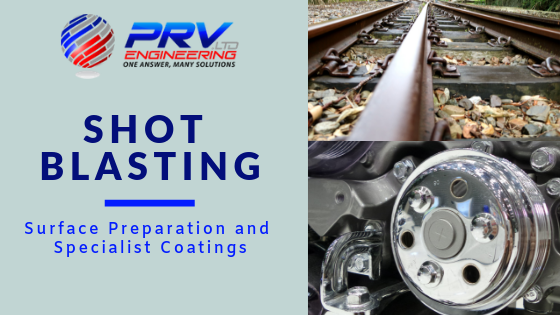
Shot blasting is used to clean, polish or strengthen metal preparing it for the application of overlays or specialist coatings. It is a technological process used to remove various impurities from different surfaces using abrasives. This includes removing rust or old layers of paint to prepare surfaces for further processing like painting, welding or powder coating. Many industries working with metal use shot blasting, including aerospace, automotive, construction, shipbuilding, rail among many others.
How Does Shot Blasting Work?
Shot blasting involves ‘firing’ small abrasive particles (shots) at an item in a controlled stream. The result depends on factors such as the particle shape, size, density and the speed at which it was projected at the object. Smaller particles create a smooth, polished finish while larger shots can remove excess forged material (flash) meaning no additional filing. It’s a vital step in surface preparation as it cleans substrates while creating a surface to hold a protective coating.
Keeping temperatures and humidity levels low is essential when preparing metal surfaces as exposure to the environment makes is more susceptible to oxidation. Effectively controlling temperature and humidity help eliminate excess moisture that could affect the application and drying of the protective coating.
Shot blasting replaces the more labour-intensive cleaning methods like wire brushing or sanding which greatly speeds up the process. The abrasive particles are also 100% recyclable making it incredibly cost effective.
Abrasive Shot Blasting Methods
There are several types of metal abrasives used in shot blasting from steel grit and copper shots to aluminium pellets. Additional shot blasting methods include using silica sand, glass beads, synthetic materials (sodium bicarbonate) and agricultural materials like crushed kernels. Take a look at the breakdown of all the major abrasive shot blasting methods:
- Micro-abrasive blasting is a dry technique using a small nozzle to direct a fine stream of abrasive material to a targeted area.
- Bead blasting uses glass beads to remove surface deposits and works well for cleaning fungus, paint and calcium deposits.
- Wheel blasting is an airless technique using centrifugal force to shoot abrasives against a surface without a propellant.
- Hydro blasting or water blasting uses high-pressure water to remove paint, chemicals and build-up of debris.
- Wet abrasive blasting uses cold or hot water to remove grease, dust and hazardous materials. Here, users can also add detergents to the water to further improve cleanliness.
- The dry ice blasting technique uses air and dry ice to remove items from a surface while it also decontaminates.
- Instead of using a blast media, bristle blasting uses a high-carbon rotary steel brush that prepares a surface.
- Vacuum blasting generates very little dust and spill as it uses dry blasting methods and collects blast media simultaneously.
Shot blasting has emerged as one of the most effective and possibly cheapest technique for surface preparation. It leads the way ahead of operations such as galvanising, electroplating, welding, enamelling, glass coating and rubberising.
Advantages of Shot Blasting
Shot blasting cleans surfaces better and faster than traditional techniques and is highly effective at removing rust from metal surfaces. With that in mind, here are some of the major benefits associated with shot blasting as a surface preparation technique.
- Shot blasting eliminates the usage of non-eco-friendly and dangerous chemicals
- Shot blasting provides higher production rates, wider abrasive selection and better blast pattern accuracy
- The finished surface is free from chemical deposits, scales and dust. Shot blasting does not remove any virgin metal when removing scales
- Shot blasting facilitates the formation of a permanent bond between the protective coat (zinc, paint or epoxy) and the shot blasted surface. It also helps detect surface faults or defects
- It increases longevity and durability of protective surface coats as it adheres better to the cleaned and scale free surface
Shot Blasting At PRV Engineering
Through ongoing investment and development at PRV, we’ve setup our own finishing department equipped with a 6 metre Shot Blast room, various Shot Blast cabinets, Powder Coating booth,Wet Spray room and a 2,2 cubic metre High Bake Oven. This allows for a very high quality painted finish to very exacting standards.
In addition to surface preparation, we also provide a high quality painted finish to very exacting standards. As part of our Busbar manufacturing services we offer a range of specialist coatings for additional insulative or conductive properties. These are applied either using electrostatic spray, fluid bath or simple heat shrink processes.
At PRV Engineering, we have also employed the means to test the finishes for the following:
- Gloss level
- Coating thickness
- Adhesion strengths
- Porosity
- Colour shade
- Dielectric strength
- Insulative or conductive properties
We are a one-stop shop providing all the services under one roof, from Busbars, 5-Axis Machining, Toolmaking, Spray painting and Powder Coating. Our manufacturing expertise extends to a wide range of industries including Automotive, Rail, Construction, Aerospace and Defense among others.
Follow our weekly blog posts for more interesting news, updates and more. Get in touch if you require a professional, experienced engineering company to assist with your project.
This site uses Akismet to reduce spam. Learn how your comment data is processed.


 Mail:
Mail: 




Leave a Comments